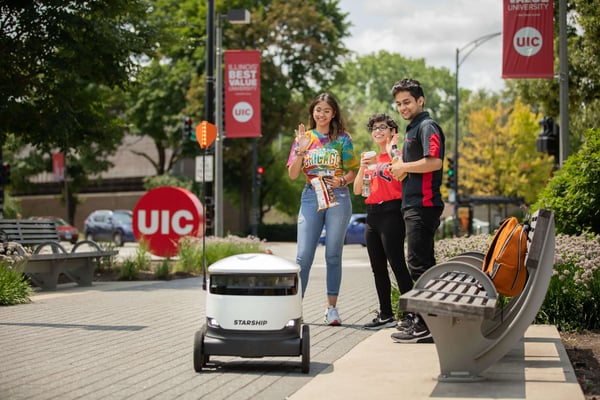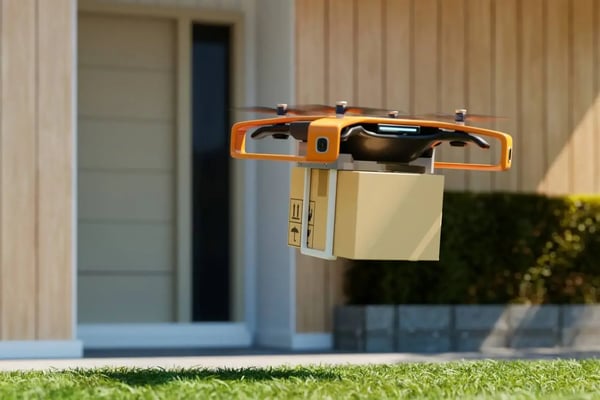A Tale of Two Mornings
Flashback to November 2022 in Bangalore, India. It’s a manic Monday, and I’m hustling my son out the door for school. He wanted cereal for breakfast, but when I opened the refrigerator, we were out of milk. With a picky eater teetering on a tantrum, we managed to get milk delivered to our doorstep within 10 minutes thanks to the lifesaving quick commerce app, Swiggy Instamart.
Fast forward to February 2025 in Boston, Massachusetts. Same morning crisis, different reality. Out of milk, we're busy getting ready and my son needs breakfast (he’s still picky, that part hasn’t changed). But this time, no 10-minute delivery app exists. I'm left wondering: why not? Why don't we have quick commerce in America like we do in India?
This experience brought a big question into focus, one that everyone in retail seems to be asking: Why hasn’t ultra-fast quick commerce taken off in the U.S., and what does that mean for the future of last-mile delivery?
Why U.S. Quick Commerce Failed: The Market Reality
We certainly have same-day delivery through platforms like Instacart and food delivery via Grubhub and DoorDash. But quick commerce and 10-minute grocery delivery never gained sustainable traction in America. The reasons matter for any retailer evaluating next-generation fulfillment. The US quick commerce landscape tells a cautionary tale. The market is projected to reach $62.63 billion in 2025 and grow to $86.70 billion by 2030, yet the path has been littered with failures. Companies like Buyk closed after just one year of operations, while Jokr pulled out of the US after losing $12 million in six months—approximately $159 per order.
The Core Challenges That Killed Quick Commerce
Infrastructure costs. Micro-fulfillment centers and dark stores, which are small, warehouse-style facilities closed to the public and designed solely to fulfill online orders, require significant real estate investment in every neighborhood they serve, driving up fixed costs dramatically.
Labor economics. High minimum wages and varying state regulations made the labor-intensive model unsustainable. Even well-funded players have struggled. Gopuff's valuation plummeted from $40 billion in January 2024 back to $15 billion by March after its IPO was canceled, and the company lost $400 million in 2023. Gopuff reduced its workforce by more than 10% and closed dozens of dark stores. Meanwhile, Instacart cut its valuation by nearly 40% to $24 billion though it has since turned profitable.
Geography and density. The US has lower population density and more dispersed urban areas compared to markets where quick commerce thrives. This means fewer orders per fulfillment location and higher per-order costs.
The Autonomous Mobile Store Alternative
There's an intriguing alternative approach that could address these challenges: autonomous mobile stores—self-driving vehicles stocked with goods that deliver directly to customer locations.
Several companies are pioneering different approaches using this model.
Robomart, for instance, deploys Level 4 autonomous vehicles (requiring no human driver in most conditions) that can carry up to 500 pounds across 10 individual lockers designed for customer orders. This structure enables batch fulfillment, allowing a single vehicle to handle multiple deliveries simultaneously. The company unveiled its RM5 autonomous delivery van in August 2025, with Austin, Texas slated as the first market⁶. While first-generation vehicles are still operated by human drivers, full autonomy is targeted for late 2025.
Nuro has partnered with major retailers like Walmart and Kroger for autonomous vehicle trials, focusing on road-based delivery pods.
Starship Technologies has completed millions of sidewalk robot deliveries, primarily on college campuses, proving the model at scale with smaller, slower robots.
The sector has attracted partnerships with major brands (Unilever, Mars, Ben & Jerry's), but funding remains modest compared to the billions poured into failed quick commerce apps—suggesting investors are taking a more cautious approach this time.
Competing Visions for Autonomous Delivery
Not all autonomous deliveries look the same. The market is exploring multiple models:
- Sidewalk Robots (Starship, Kiwibot): Small capacity, slow speeds, but proven with millions of deliveries and fewer regulatory barriers. Best for prepared food and small orders in dense areas.
- Road-based Pods (Nuro, Robomart): Larger capacity and faster speeds enable grocery fulfillment, but face more regulatory complexity, higher capital costs, and limited inventory space compared to traditional vehicles.
- Drone Delivery (Zipline, Amazon Prime Air): Fastest option for specific use cases, but extremely limited by regulations, weather sensitivity, and payload restrictions.
- Hybrid Approaches (Serve Robotics): Semi-autonomous with remote human oversight, balancing innovation with risk management during the technology maturation phase.
Each model faces different trade-offs between speed, cost, capacity, and regulatory complexity. The winner likely won't be a single approach but rather different solutions for different contexts—dense urban areas versus suburbs, prepared food versus groceries, campus environments versus residential neighborhoods.

Why Autonomous Mobile Stores Make Sense for the U.S. Market
The autonomous delivery model offers several advantages over traditional quick commerce:
- Infrastructure Efficiency: No need for expensive dark stores in every neighborhood since inventory lives in the vehicles.
- Geographic Flexibility: Better suited for urban areas where customers are more dispersed.
- Cost Reduction: Lower labor costs compared to traditional delivery models.
- Consumer Alignment: Fits established US consumer behavior around drive-up and curbside experiences.
- Transparent Pricing: Many autonomous delivery providers promise flat-fee delivery ($3-5 range) with no markups, service fees, or tips, addressing the cost sensitivity that drives US consumer behavior.
To take it one step forward, we could have autonomous mobile stores accept ad hoc orders from customers while the truck is in the vicinity as an improvement in upcoming days of operation.
What U.S. Consumers Actually Want
Here's the surprising reality. Speed isn't everything for U.S. consumers, which may explain why ultra-fast delivery startups struggled.
In 2024, 90% of consumers reported willingness to wait two or three days for deliveries—especially to avoid shipping costs. More telling, speed ranked highest in 2022 but fell to fifth place by 2024. The new priority? Cost.
More than 90% say they'll abandon purchases with high shipping costs, and about 50% won't pay anything for shipping regardless of speed.
Consumers want convenience but are cost-conscious.
The Order Management Challenge: What Autonomous Delivery Requires
Autonomous delivery isn't just a logistics shift. Autonomous delivery fundamentally changes how retailers must manage inventory and orders. Consider the operational requirements:
- Real-time inventory visibility across mobile vehicles. Unlike static warehouses or stores, inventory is constantly moving. Your OMS must track what's in each vehicle, where that vehicle is located, and whether it can fulfill incoming orders.
- Dynamic order routing based on vehicle location and capacity. Orders must be intelligently routed to the nearest available vehicle with the right inventory and capacity, factoring in the vehicle's current route and future stops
- Integration with autonomous fleet management systems. Your order management platform must communicate seamlessly with fleet operations software, exchanging real-time data on vehicle status, location, and availability.
- Batch order optimization for multi-stop deliveries. To maximize efficiency, systems must group multiple customer orders into optimal delivery routes, managing the sequence and timing of stops.
- Returns and exception handling for unmanned deliveries. What happens when a customer isn't available? When weather prevents delivery? When products need returns? Your OMS needs protocols for scenarios without human drivers to problem-solve.
These capabilities demand modern, flexible order management systems built for omnichannel complexity.
The Fulfillment Revolution Requires a System Revolution
The graveyard of quick commerce players is filled with well-funded startups that misread the American market—chasing speed when consumers prioritized cost. Autonomous delivery offers a potential solution: eliminate the most expensive part of delivery (human labor) rather than trying to make fast delivery even faster. It's about using technology to fix economics, not shave minutes off delivery times.
Whether it's Robomart's road-based vans, Starship's sidewalk robots, or an approach we haven't seen yet, the autonomous delivery model addresses the fundamental problem that killed traditional quick commerce: unsustainable cost per delivery. By eliminating the highest cost—human labor—while accepting slower growth and more realistic timelines, these companies might finally crack the code.
The question isn't whether autonomous delivery will arrive in America, but which approach will successfully navigate the unique challenges of cost-conscious consumers, dispersed geography, and complex regulations. The answer will likely be "all of the above"—different solutions for different markets, finally bringing the convenience Americans want at a price they're willing to pay.
Autonomous delivery, micro-fulfillment, quick commerce—the models may evolve, but one constant remains: retailers need order management systems that can adapt at the speed of innovation.
At Nextuple, we help retailers build the flexible omnichannel infrastructure that future-proofs their fulfillment operations. Let's talk about your roadmap.
Autonomous Delivery FAQs

